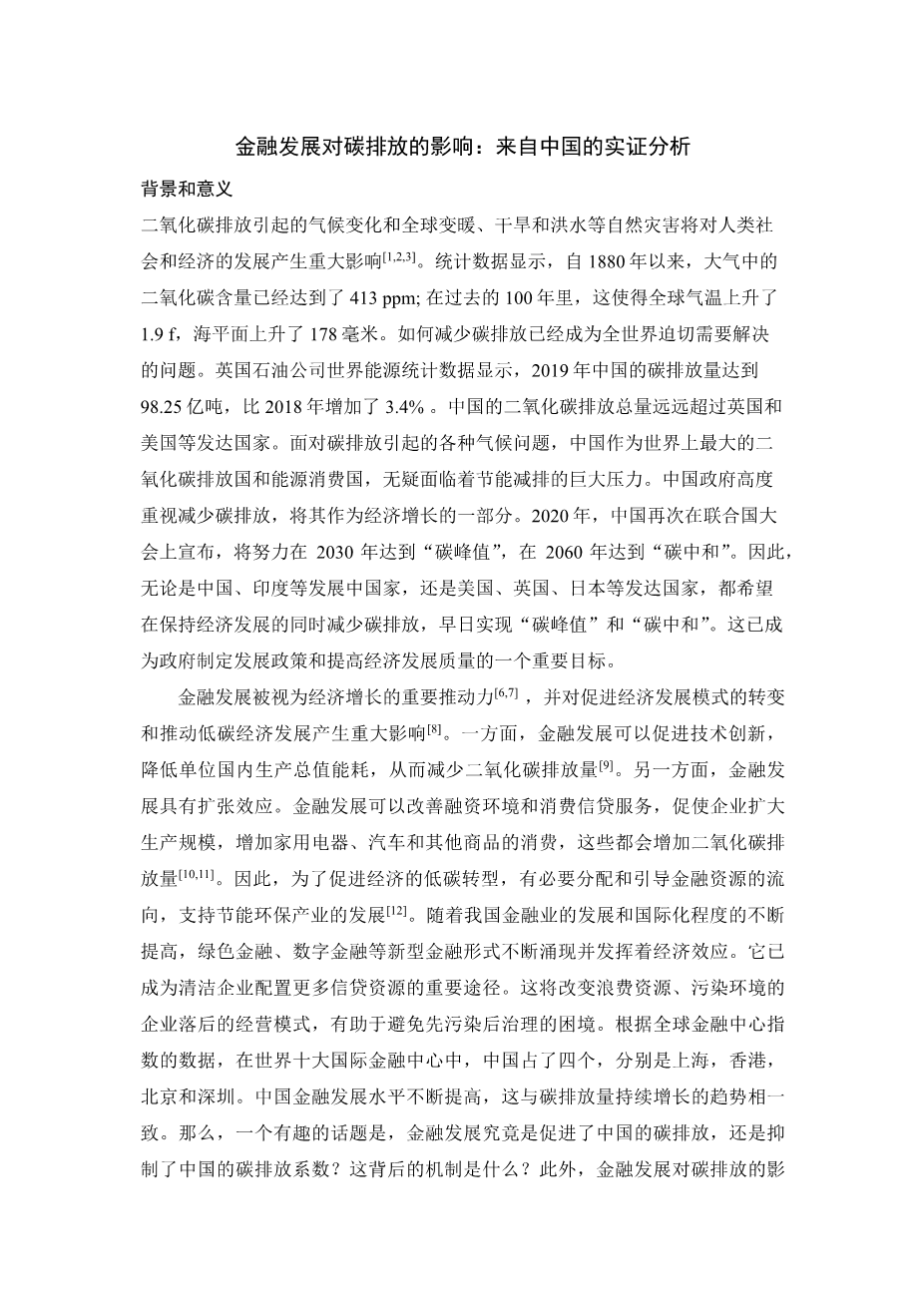The Impact of Financial Development on Carbon Emission: Evidence from China
Introduction
Climate change and natural disasters such as global warming, drought, and floods brought about by carbon dioxide emissions will have a major impact on the development of both human society and economies [1,2,3]. Statistics show that, since 1880, CO2 in the atmosphere has reached 413 ppm; over the last 100 years, this has increased the global temperature by 1.9 F and the sea level by 178 mm [4]. How to reduce carbon emissions has become a pressing issue worldwide. BP World Energy Statistics shows that Chinarsquo;s carbon emissions reached 9.825 billion tons in 2019, an increase of 3.4% compared to 2018. Chinarsquo;s total carbon dioxide emissions have far exceeded those of developed countries such as the United Kingdom and the United States. Faced with various climate problems caused by carbon emissions, China, as the worldrsquo;s largest CO2 emitter and energy consumer [5], is undoubtedly facing huge pressure to save energy and reduce emissions. The Chinese government places a high priority on reducing carbon emissions as part of the countryrsquo;s economic growth. In 2020, China once again announced at the United Nations General Assembly that it will strive to achieve a “carbon peak” by 2030 and “carbon neutrality” by 2060. Therefore, whether it is developing countries such as China and India, or developed countries such as the United States, the United Kingdom and Japan, all hope to reduce carbon emissions while at the same time maintaining economic development, and to achieve a “carbon peak” and “carbon neutrality” at an early date. This has become an important goal for the government in formulating development policies and in improving the quality of economic development.
Financial development is seen as an important driving force for economic growth [6,7], and has a significant impact on promoting the transformation of economic development models and in promoting a low-carbon economy [8]. On the one hand, financial development can promote technological innovation and reduce energy consumption per unit of GDP, thereby reducing carbon dioxide emissions [9]. On the other hand, financial development has an expansion effect. Financial development can improve both the financing environment and consumer credit services, prompt companies to expand production scale, and increase consumer consumption of household appliances, automobiles, and other commodities, all of which will also increase carbon dioxide emissions [10,11]. Therefore, to promote a low-carbon transformation of the economy, it is necessary to allocate and guide the direction of the flow of financial resources and support the development of energy-saving and environmental protection industries [12]. With the development of Chinarsquo;s financial industry and the continuous improvement in internationalization, new financial forms, such as green finance and digital finance, continue to emerge and exert economic effects. It has become an important way to allocate more credit resources to clean enterprises. This will change the backward business model of enterprises that waste resources and pollute the environment, and will help to avoid falling into the dilemma of pollution first and treatment later. According to data from the Global Financial Centers Index, among the worldrsquo;s top ten international financial centers, China occupies four, namely Shanghai, Hong Kong, Beijing, and Shenzhen. The level of Chinarsquo;s financial development continues to improve, which is consistent with the trend of continuous growth in carbon emissions. An interesting topic is then whether financial development promotes Chinarsquo;s carbon emissions or curbs its carbon emission intensity? What is the mechanism behind it? Furthermore, is the impact of financial development on carbon emissions affected by geospatial factors? The possible innovations in this paper are as follows: (1) Explain the impact mechanism of financial development on carbon emissions from three aspects: a consumption effect, an innovation effect, and a structural effect. (2) This paper uses Chinese city data from 2005 to 2018 to empirically test the impact of financial development on carbon emission intensity and to consider the role of geospatial factors on the impact of financial development on carbon emission intensity. We further test whether this role exists in the heterogeneity of urban areas so as to provide a theoretical basis for evaluating the emission reduction effects of financial development.
Influence Mechanism
From a theoretical point of view, financial development may reduce carbon emissions both by promoting technological innovation to achieve cleaner production and by adjusting the industrial structure. It is also possible to increase energy consumption and promote carbon emissions through the expansion of consumer demand and economic scale. As a result, the influence of financial growth on carbon emissions remains uncertain, dependent on the contrast between the positive and negative effects of carbon emissions.
The Effect of Technological Innovation
Technological innovations such as renewable energy technologies and cleaner production technologies are important factors in reducing carbon emissions [26,28,29]. Through research and development, innovation, and the application of green technology to actual production, emissions of CO2 can be effectively reduced. Financial development will promote technological innovation by three means, and so reduce carbon emissions. The first is to reduce financing costs and promote technological innovation. Enterprise technological innovation is a complex and special input–output process with high-risk and high-input characteristics. Whether or not it ca
剩余内容已隐藏,支付完成后下载完整资料


英语译文共 4 页,剩余内容已隐藏,支付完成后下载完整资料
资料编号:[589567],资料为PDF文档或Word文档,PDF文档可免费转换为Word


